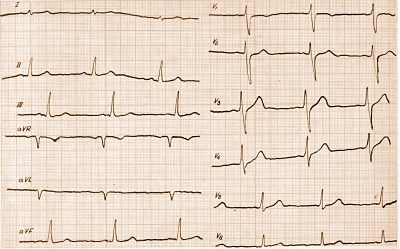Vertical bradycardia
Author Ольга Кияница
2017-11-10
Verticular bradycardia is a combined symptom that develops with a reduction in the frequency of heart cramps and the determination of the vertical axis of the heart. This is often found in childhood, when the body is intensively mature and there is no necessary support for skeletal muscle.
Not in all cases, vertical bradycardia leads to complications.Yet, in some cases, the disease must be subjected to careful diagnosis and treatment.
For the study of the presented violation, standard research methods are used, which, if necessary, are supplemented by specific diagnostics (analyzes, tests, loading tests). It is especially important to know if there is a problem with the heart in order to contact the cardiologist in a timely manner.
Video How to check if there is a heart problem?
Description of vertical bradycardia
The term "bradycardia" refers to the definition of heart rate below the age limit (in adults it is 60 av / min). The development of this condition is often associated with other disorders, including the vertical location of the heart.
The electric axis of the heart is an electrocardiographic indicator that indicates the electrical parameters of the heart.
The heart is a three-dimensional organ, which is medically located on a coordinate grid. When studying the location of the heart on this grid, a concept emerged such as EOS - the electric axis of the heart. Its verticality is said to be in the case when its limits range from +70 to +90. This arrangement is often observed in people with asthenic physique - high growth, thin arms and legs.

In the normal state, the EOS is determined within the range of +30 ... + 90, whereas the heart axis can range from 0 to +90.
In most cases, the detection of the vertical axis of the heart is not considered pathology. In the part of the subjects, a combination of the vertical axis of the heart and bradycardia is detected, and only a careful study of this condition helps establish the need for medical treatment.
Symptoms of vertical bradycardia
The change in the electrical axis of the heart is not expressed clinically. The presence of a non-standard condition may indicate bradycardia, in which the following symptoms are determined:
- weak pulse;
- dizziness;
- general weakness;
- sensation of "weak heart".
In severe cases, the heart can be so rarely shortened that the patient is able to lose consciousness. Such conditions are dangerous to heart failure, so timely treatments should be taken.
Reasons for the appearance of vertical bradycardia
In some diseases, the vertical axis of the heart is most often defined. First of all - ischemic heart disease and cardiomyopathy of a different nature (mainly dilatation). Other pathologies accompanied by vertical EOS are congenital heart defects and chronic heart failure.
Bradycardia develops for various reasons. Most often - with blockages of varying degrees of severity. There is also a pathology such as weakness of the sinus node. It can also be determined by an uncompromising heart rate. If bradycardia is so pronounced that a person can not feel and work normally, then even with normal EOS, special treatment is required.
Diagnosis of vertical bradycardia
An electrocardiogram is used to determine bradycardia and electrical location of the heart. With its help, for a fraction of a second, the electric impulse changes are captured, which form the magnitude of the EOS.

As an example of an ECG conclusion that can be given to the subject, the following can be summarized as follows: "The vertical position of the electric axis of the heart. The heart rate is 45 bpm. "It is indicated not only on the vertical EOS but also on the bradycardia.
Treatment and prevention of vertical bradycardia
If the vertical axis of the heart is determined without any other changes, then specific treatment is not carried out. A similar condition is considered a cardiological parameter, which should first be studied in terms of causative factors.
In the presence of combined pathology, such as vertical bradycardia, a specific treatment may be required. Especially if the heart rate is greatly reduced or blockade determined. In severe cases, a pacemaker is implanted.
